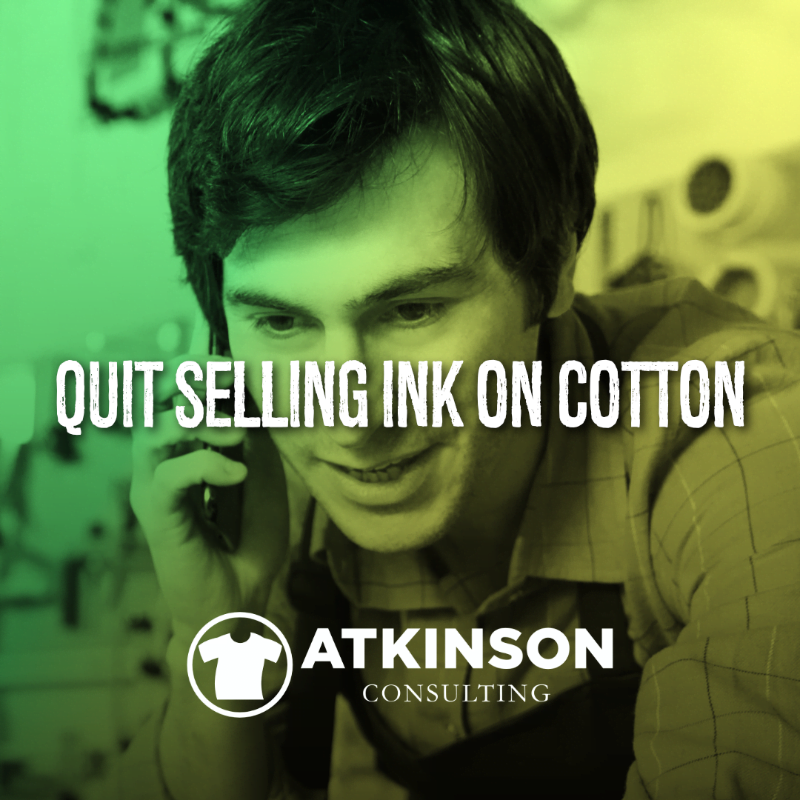All too often in this industry the following scenario happens:
Customer: “I need to get some shirts printed.”
You: “How many do you need?”
Customer: “About 100.”
You: “What color shirt, and what will the design look like?”
Customer: “Black shirts, and just our logo on the front and back. I need the phone number too. Everything in a light blue color.”
You: “Ok, here’s your quote…”
Customer: “That much? Ok, thanks. I can get it cheaper somewhere else.”
Who can spot what’s wrong with this conversation? It’s oversimplified of course, but you get the gist of what I’m going after here.
If you want to be treated as a commodity, this is a perfect way to go.
Take A Different Approach
Plenty of famous marketing gurus, authors, and even blog articles on this site have talked about the importance of selling your “value”. Have you ever stopped to think about what this means?
Your value to your customer isn’t that you can print a t-shirt. (Or embroider, heat-press, dye sublimate, or add vinyl)
Any knucklehead down the street can do that.
The value that I’m suggesting is about taking a different approach. This one requires more effort on your part, but it will pay off for you in the long run. It is very simple.
Ask better questions.
Seek First To Understand
What will the practice of asking better questions unlock that simply firing off a quote will never do?
Questions establish trust, authority, and expertise.
They lay the groundwork for building a personal relationship. Remember, people don’t do business with their enemies, they do business with their friends.
One of your main jobs in sales is to establish long term connections with your customers so they stick with you forever. That won’t happen if you act like an order taker.
Let’s look at that same situation, but we’ll throw in some questions.
Customer: “I need to get some shirts printed.”
You: “Great! You have come to the right place. Let’s talk about what you are doing with the shirts.”
Customer: “We are bringing together our employees for a special meeting to celebrate being in business for fifty years. It’s truly a landmark occasion, and the shirts are part of the gift bag everyone will be receiving.”
You: “Wow! Fifty years! That’s amazing, congratulations! Do you have a special logo or artwork for the event?”
Customer: “No, we were just thinking of simply putting our logo on the shirt. We don’t want to spend any extra money on art.”
You: “Is the idea of giving t-shirts away important to you?”
Customer: “Of course, we want people to have something to remember the event and wear for a long time.”
You: “Ok, how about you let our creative team work up a special design for the event? No charge. Can you shoot over your company logo?”
Customer: “Fantastic! I’ll email that to you today.”
You: “Also, let’s talk t-shirt blanks. You are giving these away, but you want them to be special, correct?”
Customer: “That’s right! We’re trying to celebrate and create a special memory for our staff. Everyone has been working so hard and has been through so much lately. This event will be the key rallying point for us for this year and probably next.”
You: “Great! I have the perfect t-shirt. It is a higher-end shirt, incredibly soft, and with the special design we are going to put together for you, it will be their favorite memento from the celebration. Would you like to see a sample?”
Customer: “Sure. We were thinking of using a black shirt. Does it come in that color?”
You: “Of course. That’s a standard color for most t-shirt lines. However, have you thought about using a brighter color and make the t-shirt a little more festive?”
Customer: “Not really, but that may be a good idea. I was thinking black just because that’s the shirt color my kid wears most often. I didn’t really even consider something else.”
You: “Ok, let’s have our design team work up that celebration art, and we’ll show it to you on two or three shirt colors and see what you like. At this stage, doing mockups is a great way to test the waters and unlock some imagination on possibilities.”
Customer: “Wow, that sounds terrific. Thanks.”
You: “By the way, what else are you putting in your gift bag for everyone?”
Customer: “Well, we were thinking of a water bottle, some snacks, a special note from our CEO, and other goodies.”
You: “Ok, how does this sound? We can put the special celebration design that we are creating on a canvas tote bag, the water bottle, on some delicious chocolates, and we can even help get your note from the CEO printed.”
Customer: “And to think I was just calling to get t-shirts printed! That’s amazing. I didn’t really know you did all of that. What do we need to do to get started?”
Position Yourself As A Problem Solver
In the above example, the direction isn’t to instantly dive into the quote process. Instead, it is about uncovering needs and wants.
Sure, it might be easier to go the brainless route and simply fire off a quote using your standard go-to t-shirt with your price matrix. That’s the same lame approach that everyone else in your area uses.
But if you spend the time uncovering the real problem, which in this scenario they wanted to create a special memory for their employees, you can unlock a higher value to your customer. This creates trust and signals your expertise as a problem solver.
Here, not only is the customer buying a higher quality t-shirt for the event, but water bottles, chocolates, tote bags, and some specially printed notecards.
Find out what is important to your customer.
It isn’t the price of ink on cotton.
“Don’t wait for extraordinary opportunities. Seize common occasions and make them great. Weak men wait for opportunities. Strong men make them.” – Orison Swett Marden
“Be larger than your task.” – Orison Swett Marden
“The quality of your work, in the long run, is the deciding factor on how much your services are valued by the world.” – Orison Swett Marden
Are You Stuck?
Lastly, I want to plug the new book that I just released recently, “Moving Past Disaster”. I know a lot of people are in a quandary about what to do with their business to rebound past this current pandemic situation. Is that you?
Throughout my career, I have been using some creative mental tools to help me unlock new ideas. From being an art director to a Chief Operating Officer, these were methods that I’ve had in my mental toolbox for years.
When the pandemic struck and it was clear that it was going to bulldoze the world, I knew that these tools could make an impact on business owners that are struggling to find their way out of the situation. It was written for you.
Use tried and true creative mental models to unlock a new direction for your business. “Moving Past Disaster” has tips, checklists, exercises, examples, and many creative thought planning ideas to provoke you into action and guide you to a new successful future. Use the Workbook pages to help organize your thoughts, delegate tasks, or consider a new perspective. When you are finished reading this book and completing the exercises as outlined you will be able to:
- Snapshot your current problems
- Develop new ideas
- Create a new Business Plan
- Deploy a 2-Year Action Plan
Your situation was an event. Events end.
It is time to get working shaping your new future. Let “Moving Past Disaster” guide you through the process of developing new ideas that you can use for that journey.






2 comments
Chris Wilson
This is the quality content I’ve been waiting for.
Marshall Atkinson
Thanks Chris! Be sure to check out other blog articles on this site that may help you. – M